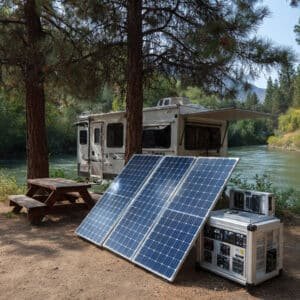When it comes to sustainable and eco-friendly prepping, mushrooms are one of the most underrated resources for self-sufficiency. These versatile fungi offer a wide range of benefits, from providing nutrition to enhancing soil quality, and can be grown with minimal effort and environmental impact. Whether you’re preparing for long-term self-reliance or just looking to supplement your homestead, mushrooms are an excellent addition to your prepping strategy.
Why Mushrooms?
Mushrooms are a sustainable, low-impact crop that can be grown in nearly any environment. They require little space, minimal water, and can thrive indoors, outdoors, or even in small urban spaces. With the right conditions, many mushroom species grow quickly, producing a reliable food source in just a few weeks.
Beyond their easy cultivation, mushrooms provide a valuable source of nutrition. They’re high in protein, vitamins (like B and D), antioxidants, and fiber. In prepping scenarios where traditional crops may fail, mushrooms can step in as a key source of nutrients.
Types of Mushrooms for Preppers
Not all mushrooms are created equal when it comes to prepping. Here are some species that are particularly useful for self-sufficient living:
Oyster Mushrooms: Easy to cultivate on a wide range of substrates (such as coffee grounds or straw), oyster mushrooms are perfect for beginners. They grow fast and are packed with protein.

Back to the Roots Mushroom Growing Kit
Versatile and beginner-friendly.

Root Mushroom Farm Oyster Mushroom Grow Kit
Includes everything needed for a successful grow.

Mushroom Adventures Oyster Mushroom Kit
Comprehensive kit for a variety of substrates.

The Mushroom Lady Oyster Mushroom Kit
Ideal for growing oyster mushrooms on various materials.
Shiitake Mushrooms: Grown on hardwood logs, shiitakes are rich in flavor and nutrients. Their longer cultivation time makes them a good option for long-term harvest planning.
Lion’s Mane: Known for its medicinal properties, including boosting cognitive function, Lion’s Mane can be grown indoors with minimal effort.

Lion’s Mane Mushroom Grow Kit
Perfect for indoor cultivation.

North Spore Lion’s Mane Grow Kit
Comprehensive kit for easy growth.

Root Mushroom Farm Lion’s Mane Kit
Includes all essentials for successful cultivation.

Mushroom Adventures Lion’s Mane Kit
Great for beginners and experienced growers alike.
Button Mushrooms: These common mushrooms are easy to grow in composted manure or a home compost system and offer a familiar taste for meals.
Tips for Growing Mushrooms as a Prepper
Growing mushrooms may seem daunting at first, but with the right approach, it’s a straightforward process that can easily be incorporated into any prepping strategy. Whether you’re a beginner or have some gardening experience, these tips will help you grow mushrooms successfully.
1. Choose the Right Species
Different mushroom species require different growing conditions, so it’s important to start with the right type based on your environment and needs.
- Oyster Mushrooms: Great for beginners and thrive on simple substrates like straw, coffee grounds, or cardboard. They can be grown indoors or outdoors.
- Shiitake Mushrooms: Require hardwood logs or sawdust and need a longer incubation period but offer a rich flavor and multiple harvests.
- Button Mushrooms: Grow well in composted manure, making them suitable for home compost systems.
- Lion’s Mane: Prefer indoor cultivation in hardwood sawdust, and they offer both nutritional and medicinal benefits.
2. Create the Right Environment
Mushrooms need a specific environment to thrive. Here are key elements for successful cultivation:
- Temperature: Most mushrooms grow best between 60-75°F (15-24°C), but some, like shiitakes, can tolerate cooler temperatures.
- Humidity: Mushrooms need high humidity to grow. If growing indoors, you can mist your growing area or use a humidity tent or room. Outdoors, keep them in shaded, moist locations.
Light: Mushrooms don’t need direct sunlight. In fact, they grow best in low-light or shaded conditions. A dark room, closet, or basement works well for indoor cultivation.
3. Prepare Your Growing Medium (Substrate)
The substrate is what mushrooms grow on, and different species thrive on different materials. Preparing the right substrate is critical for success.
For Oyster Mushrooms: Use sterilized straw, wood chips, or even used coffee grounds as a substrate. These materials are easy to come by and eco-friendly.
For Shiitake Mushrooms: They thrive on hardwood logs or sawdust blocks. If using logs, make sure the wood is fresh, as shiitake mycelium needs nutrients from the living wood.
For Shiitake Mushrooms: They thrive on hardwood logs or sawdust blocks. If using logs, make sure the wood is fresh, as shiitake mycelium needs nutrients from the living wood.
4. Inoculation: Adding Mushroom Spawn
Mushroom spawn (mycelium) is the equivalent of seeds for plants. It’s what you add to your substrate to grow mushrooms.
- For Logs: Drill holes into the log and fill them with shiitake spawn plugs, then seal with wax to prevent contamination.
- For Substrates: Mix your chosen mushroom spawn with the substrate material. Ensure everything is sterile to avoid contamination. Oyster mushrooms, for example, can be mixed into straw or wood chips.
5. Incubation Period
Once inoculated, the mushroom spawn needs time to colonize the substrate or log. This is called the incubation phase.
- Keep in a Dark Place: For most mushrooms, keep the growing material in a dark, warm spot for 2-4 weeks until the mycelium has fully spread.
- Monitor Moisture: Make sure your substrate stays moist but not soaking wet. If growing indoors, mist the substrate regularly or use a damp cloth to cover it.
- Look for Mycelium Growth: After a few weeks, you should see white, thread-like structures (mycelium) spreading through the substrate. This indicates that colonization is successful.
6. Fruiting: Trigger Mushroom Growth
Once your mycelium has fully colonized the substrate, you’ll need to create conditions that trigger fruiting—the stage when mushrooms start growing.
- Increase Humidity: Mushrooms need a humid environment to fruit. You can increase humidity by misting or placing a humidity tent over your growing area.
- Lower Temperature: Many species, such as shiitake, respond to cooler temperatures to start fruiting. Moving logs outside during cooler months or lowering indoor temperature slightly can help.
- Provide Indirect Light: Mushrooms don’t need direct sunlight but benefit from low-light exposure during fruiting. If growing indoors, a small LED light or natural light from a window will suffice.
7. Harvesting Your Mushrooms
Mushrooms grow quickly once they start fruiting, so keep an eye on your crop.
- When to Harvest: Most mushrooms should be harvested when the caps are still closed or just beginning to open. Waiting too long can cause them to release spores, reducing flavor and yield.
- Harvest Gently: Use a sharp knife or twist mushrooms at the base to avoid damaging the mycelium, allowing for more flushes (cycles) of mushrooms to grow later.
8. Recycle the Substrate
Once your mushroom crop is finished, don’t throw away the substrate. It still has value!
- Compost It: Mushroom-growing substrate, especially if it’s straw or sawdust, is a great addition to your compost pile. It can help enrich your garden soil for future plant crops.
- Re-Inoculate: You can try inoculating the spent substrate with new spawn to potentially yield another crop of mushrooms.
9. Grow Mushrooms in a Small Space
For preppers with limited space, mushrooms are an ideal crop. They can be grown in containers, buckets, or even hanging bags, allowing for vertical farming. This makes them perfect for small apartments or homesteads.
Preserving Mushrooms
Mushrooms don’t just have to be consumed fresh. Drying mushrooms is an easy method for long-term storage, and dried mushrooms can last for years if kept in a cool, dark place. You can also powder dried mushrooms for soups and sauces, or incorporate them into homemade seasoning blends, maximizing their usefulness.
Final Thoughts
Mushrooms offer a powerful combination of nutrition, sustainability, and medicinal benefits, making them an essential resource for eco-friendly prepping. By learning to cultivate and incorporate mushrooms into your self-sufficiency strategy, you can reduce waste, enhance your food security, and create a more resilient and sustainable prepper lifestyle.
Whether you’re new to prepping or looking to expand your homestead’s capabilities, consider adding mushrooms to your list of must-have resources. In times of uncertainty, these humble fungi could very well become one of your most valuable assets.
















































